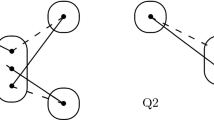Abstract
Many problems and applications can be naturally modelled and solved using constraints with more than two variables. Such n-ary constraints, in particular, arithmetic constraints are provided by many finite domain constraint programming systems. The best known worst case time complexity of existing algorithms (GAC-schema) for enforcing arc consistency on general CSPs is O(edn) where d is the size of domain, e is the number of constraints and n is the maximum number of variables in a single constraint. We address the question of efficient consistency enforcing for n-ary constraints. An observation here is that even with a restriction of n-ary constraints to linear constraints, arc consistency enforcing is NP-complete. We identify a general class of monotonic n-ary constraints (which includes linear inequalities as a special case). Such monotonic constraints can be made arc consistent in time O(en 3 d). The special case of linear inequalities can be made arc consistent in time O(en 2 d) using bounds-consistency which exploits special properties of the projection function.
Access this chapter
Tax calculation will be finalised at checkout
Purchases are for personal use only
Preview
Unable to display preview. Download preview PDF.
Similar content being viewed by others
References
F. Bacchus and P. van Beek, “On the conversion between non-binary and binary constraint satisfaction problems”, Proceedings of AAAI-98, Madison, WI, 1998
F. Benhamou, D. McAllester, and P. van Hentenryck, “CLP(intervals) Revisited”, Proceedings of 1994 International Symposium on Logic Programming, 124–138, 1994
F. Benhamou and W. Older, “Applying Interval Arithmetic to Real Integer and Boolean Constraints”, Journal of Logic Programming32(1), 1997
C. Bessiere, “Arc-consistency and arc-consistency again”, Artificial Intelligence 65:179–190, 1994
C. Bessiere and J. Regin, “Arc consistency for general constraint networks: preliminary results”, Proceedings of IJCAI-97, Nagoya, Japan, 1997
C. Bessiere and J. Regin, “MAC and combined heuristics: two reasons to forsake FC(and CBJ?) on hard problems”, Proceedings of Principles and Practice of Constraint Programming, Cambridge, MA. 61–75, 1996
P. Codognet and D. Diaz, “Compiling Constraints in CLP(FD)”, Journal of Logic Programming 27(3), 185–226, 1996
E. Davis Constraint Propagation with Interval Labels Artificial Intelligence 32, 281–331, 1987
R. Dechter, I. Meiri and J. Pearl Temporal constraint networks Artificial Intelligence 49, 61–95, 1992
R. Dechter and J. Pearl, “Tree clustering for constraint networks”, Artificial Intelligence 38:353–366, 1989
E. Hyvonen Constraint reasoning based on interval arithmetic: the tolerance propagation approach Artificial Intelligence 58, 71–112, 1992
ILOG, ILOG SOLVER Reference Manual
Joxan Jaffar, Michael J. Maher, Peter J. Stuckey and Roland H. C. Yap Beyond Finite Domains PPCP’94: Proceedings of the Second Workshop on Principles and Practice of Constraint Programming, 1994, 86–94
J. Lauriere, “A language and a program for stating and solving combinatorial problems”, Artificial Intelligence 10:29–127, 1978
Y. Lebbah and O. Lhomme Acceleration methods for numeric CSPs Proc. of AAAI-98 1998
Lhomme, Olivier, Consistency Techniques for Numeric CSPs, Proceedings of IJCAI-93, Chambery, France, 232–238, 1993
A. K. Mackworth, “Consistency in Networks of Relations”, Artificial Intelligence 8(1):118–126, 1977
A. K. Mackworth, “On reading sketch maps”, Proceedings of IJCAI-77, 598–606, Cambridge MA, 1977
R. Mohr and G. Masini, “Good old discrete relaxation”, Proceedings of ECAI-88, 651–656, Munchen, FRG, 1988
R. E. Moore, Interval Analysis, Prentice Hall, 1966
G. L. Nemhauser and L. A. Wolsey, Integer and Combinatorial Optimization, New York, Wiley, 1988
Older W. and Vellin, A. Constraint Arithmetic on Real Intervals Constraint Logic Programming: Selected Research, Benhamou, F. and Colmerauer, A.(eds.), 175–195, 1993
C. H. Papadimitriou, “On the complexity of integer programming”, J. of the ACM 28(4):765–768, 1981
J. C. Regin, “Generalized arc consistency for global cardinality constraint”, Proceedings of AAAI-96, 209–215, Portland, OR, 1996
F. Rossi, C. Petrie, and V. Dhar, “On the equivalence of constraint satisfaction problems”, Proceedings of the 9th European Conference on Artificial Intelligence, 550–556, Stockholm, Sweden, 1990
P. van Beek and R. Dechter, “On the minimality and global consistency of row-convex constraint networks”, Journal of the ACM 42(3):543–561, 1995
P. van Hentenryck, Constraint Satisfaction and Logic Programming, MIT Press, Cambridge, 1989
P. van Hentenryck, Y. Deville, and C. M. Teng, “A Generic Arc-Consistency Algorithm and its Specializations”, Artif. Int. 58(1992):291–321, 1992
P. van Hentenryck, L. Michel, and Y. Deville, Numerica: A Modeling Language for Global Optimization, MIT Press, Cambridge
D. L. Waltz, “Generating semantic descriptions from drawings of scenes with shadows”, MAC-AI-TR-217, MIT, 1972
Author information
Authors and Affiliations
Editor information
Editors and Affiliations
Rights and permissions
Copyright information
© 2000 Springer-Verlag Berlin Heidelberg
About this paper
Cite this paper
Yuanlin, Z., Yap, R.H.C. (2000). Arc Consistency on n-ary Monotonic and Linear Constraints. In: Dechter, R. (eds) Principles and Practice of Constraint Programming – CP 2000. CP 2000. Lecture Notes in Computer Science, vol 1894. Springer, Berlin, Heidelberg. https://doi.org/10.1007/3-540-45349-0_34
Download citation
DOI: https://doi.org/10.1007/3-540-45349-0_34
Published:
Publisher Name: Springer, Berlin, Heidelberg
Print ISBN: 978-3-540-41053-9
Online ISBN: 978-3-540-45349-9
eBook Packages: Springer Book Archive





